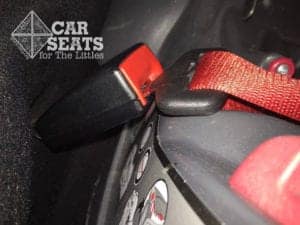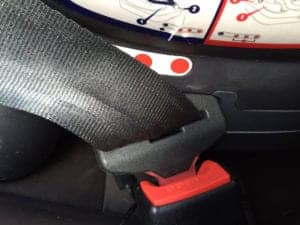One topic that frequently comes up on our Facebook group is buckle crunch. This is an issue that can make installation impossible, so it’s important to know what to look for to ensure a safe and secure car seat. Between the United States and Europe, there are different rules around a common fix to this problem so we wanted to explain how that works.
What Is Buckle Crunch?
Buckle crunch is not a candy bar. It’s a tricky situation where the vehicle seat belt’s buckle is pulled up into the belt path of a car seat. Instead of the seat belt webbing doing all the work of restraining the car seat, the hard plastic of the buckle is pulled inside the belt path. This makes for an insecure installation because the seat can shift along the hard plastic of the buckle, causing unpredictable movement.
How to Fix It
In North America, one common solution to this issue is to twist the seat belt buckle stalk to make it shorter and bring the buckle down out of the belt path.
While twisting the buckle stalk has resolved the issue for countless North American caregivers, it is not permitted to twist the buckle stalk to reduce buckle crunch with European car seats.
A few car seats, including the Britax Two Way Elite or Britax First Class Plus, have alternate installation methods that can remedy buckle crunch. For car seats that don’t have alternate installation methods, moving the car seat to another seating position in the vehicle may do the trick.
Unfortunately, in some cases, a car seat is simply incompatible in the vehicle and will need to be replaced.
Vehicles with long buckle stalks tend to be prone to buckle crunch. Likewise, the design of some car seats causes them to be more likely to have buckle crunch. Trying the seat in your vehicle before you buy is always a good idea! Even “universal” seats have incompatibilities in some vehicles, and finding that out in advance can save time and your wallet.



